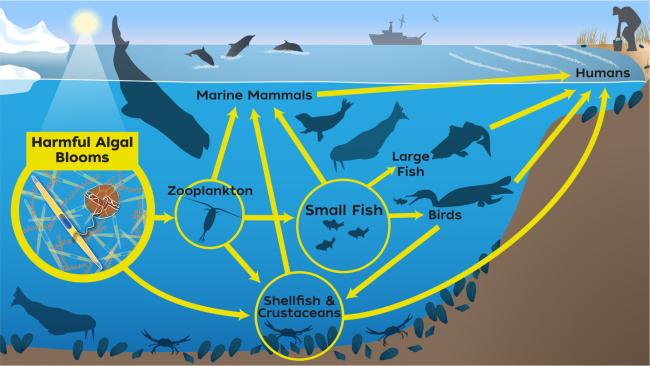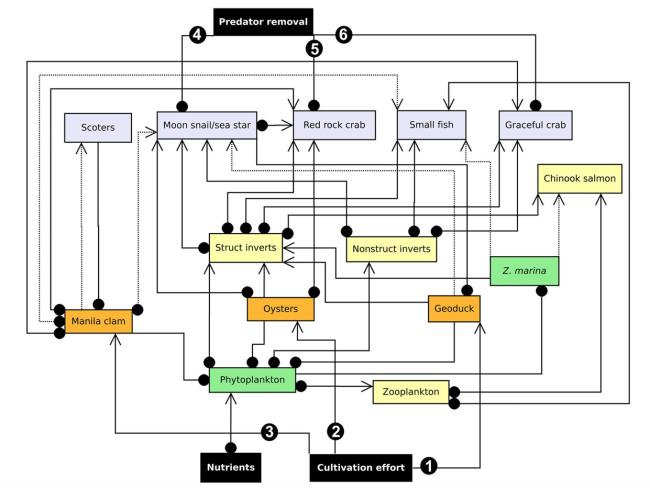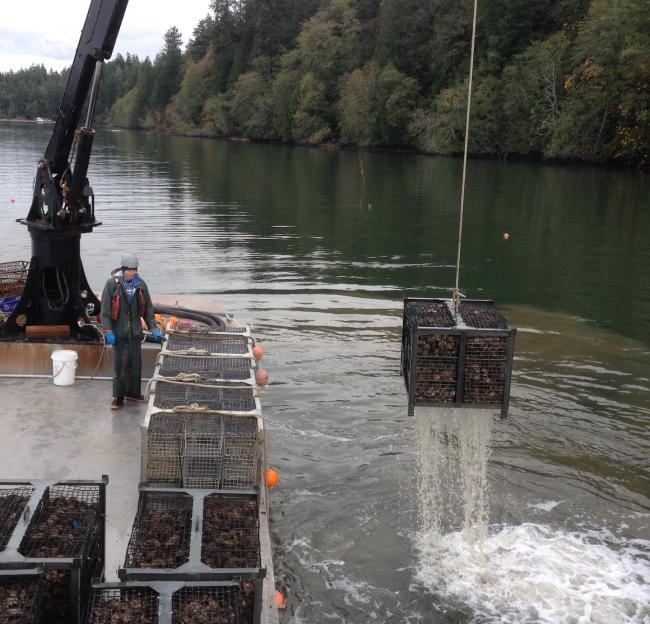Researchers use a qualitative network model to test ways to boost production at shellfish farms
The skeletal beginnings of nearly all models is a conceptual understanding of the basic workings of the system being studied: Who are the important actors, and what are their roles within the system?

Looking at a basic food web, for example, the key question becomes “who is eating whom?” A conceptual model, depicted as a diagram, places separate species (or groups of species) within various boxes with arrows pointing from prey to predators, showing the pathway of consumption. Of course, some predators are also prey, so their boxes have arrows coming and going.
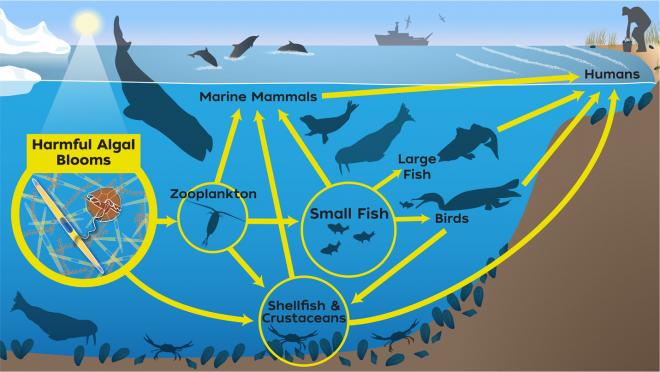
For scientific studies, conceptual models can be used to describe features and actions within the physical realm. Conceptual models also can be used in social science, economics and business transactions, as well for dealing with processes — such as in computer programming or project planning. Two or more realms can be combined in a single conceptual model. For example, an increase in a fish population can point to an increase in fishing, which can lead to an increase in personal income.
Going one step beyond the conceptual model into the analytical world leads to a framework that depends largely on an understanding of how the different actors affect each other, without really addressing how much they do so. In a “qualitative network model,” the focus is on getting the relationships right, not the levels of output for a given input.
“In a way, with qualitative network models, we are trying to see how much we can get away with not knowing,” said Jon Reum, a researcher with NOAA’s Alaska Fisheries Science Center. “You are worried about the system as a whole, but you are not hamstrung by data availability.”
Reum, who has studied modeling techniques, developed a qualitative network model to see if shellfish farmers can take actions to improve overall shellfish production in South Puget Sound. He chose to focus on Manila clams, oysters and geoduck clams. Predators included scoters (sea ducks), moon snails, sea stars, red rock crabs, small fish and graceful crabs. As shown in the chart, Manila clams are susceptible to five of the predators, compared to two predators for oysters and one for geoducks. Other players in the network model include invertebrates and Chinook salmon, with a key group being phytoplankton, which directly feed the shellfish.
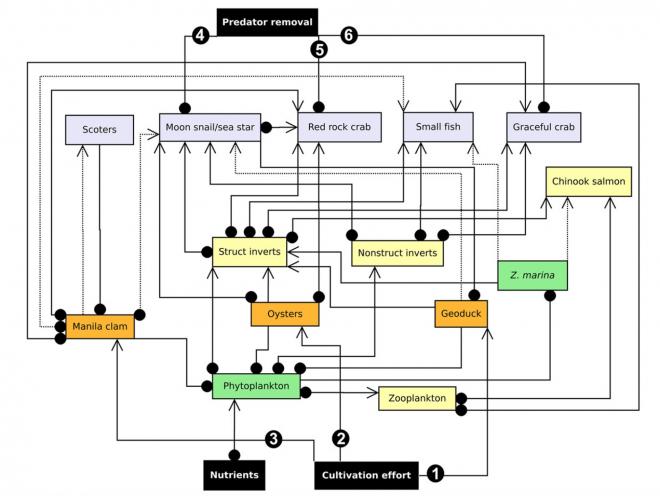
Alternative actions being studied to increase production: 1) increase nutrients to increase phytoplankton, 2) increase cultivation of each type of shellfish, and 3) decrease predation by removing or excluding one or more selected predators through well-known techniques.
A probability-based approach can provide some insight into which actions could be the most helpful in enhancing shellfish production. In a qualitative network model, each interaction between species is assumed to be positive or negative for at least one of the species. In that vein, a predator-prey relationship is considered positive for the predator and negative for the prey. Likewise, proposed actions are positive or negative, depending on the effects.
No assumptions are made about the actual strength of the positive and negative interactions. Without getting into complex matrix algebra, the model allows positive effects to range from 0 to +1 and negative effects to range from 0 to -1. The interactions among all the various actors in the system form a matrix that can be analyzed to describe their combined effects on the system. Scenarios are put forth to test the effects of actions. One scenario could increase nutrients or shellfish cultivation. Another could decrease one or more predators. Any combination of such actions may be proposed in the model.
Because the strength of the linkages are not known, the model randomly assigns a strength between 0 to +1 for positive linkages and between 0 to -1 for negative linkages. Excluding results considered “unstable” in mathematical terms, the final result comes out either positive or negative. By running the same scenario hundreds or thousands of times with different random inputs produces a large set of positive and negative values. If a large proportion — say 70 percent or more — come out positive for shellfish production, then the actions used in the scenario suggest a potential benefit to shellfish production.
“The main strength of this tool is to scope what a more quantitative model would look like,” Reum said. “What linkages are most important? Only a handful of the interactions in this system turned out to be important to predicting the outcome.”
Reum and his collaborators described this qualitative network model in much detail, along with results, in an article published in the Journal of Marine Science published by the International Council for the Exploration of the Sea.

Results revealed interesting relationships among the species when taking various management actions. For example, cultivation of geoducks increased the production of geoducks, as expected, but it also decreased production of Pacific oysters. Similarly, cultivation of Pacific oysters increased oyster production but decreased production of Manila clams.
“Such patterns are likely due to indirect pathways involving the predator red rock crab, wherein an increase in one bivalve results in higher abundances of red rock crab, which increases predation on other bivalve prey,” the report states.
Predator control was found to have varying effects. Removal of red rock crab decreased geoducks while increasing Manila clams. Removal of graceful crabs decreased Pacific oysters while increasing Manila clams. These outcomes seem to result from the ability of qualitative network models to incorporate direct effects, indirect effects as well as feedback loops that arise from “complex ecological interactions that might otherwise be difficult to anticipate.”
Species trade-offs predicted by the model may have economic implications that can be incorporated into management decisions. For example, a pound of Pacific oysters is about 40 percent more valuable than a pound of Manila clams, while geoduck clams are worth more than four times as much as Manila clams.
“QNMs provide imprecise predictions,” Reum concludes in the paper, “but this can be viewed as advantageous, because emphasis is moved away from the precise measurement of parameters (which may be costly, difficult or impossible to do) and towards understanding the main processes and community interactions…”
This article is part of a series focused on different models and their uses within the Puget Sound ecosystem. The project is jointly sponsored by King County and the Puget Sound Institute.
Other articles in the series:
Six things that people should know about ecosystem modeling and virtual experiments
Before supercomputers, a structural model helped scientists predict currents in Puget Sound
Health of killer whales examined through Bayesian network modeling and informed predictions
Quantitative models, including Ecopath, take food web studies to a higher level of analysis
Prey and predators create varying life-or-death conditions for salmon, as shown with Atlantis model


